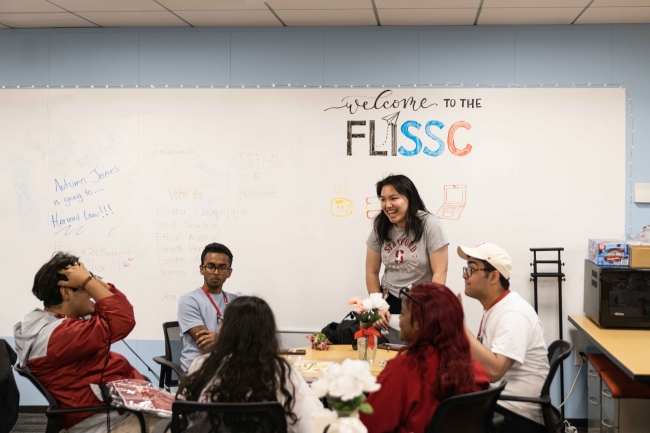You have /5 articles left.
Sign up for a free account or log in.

The First-Generation, Low-Income Student Success Center at Stanford University received donor support for an endowed directorship and financial aid for students’ experiential learning, research and tuition.
Thomas Yim/Ethography
Across the country, centers for diversity, equity and inclusion have endured attacks from conservative lawmakers, resulting in closures, renaming of centers or redistribution of resources across campus.
At Stanford University, meanwhile, donor support has added a new level of sustainability to the university’s community centers. In recent years, four of the eight community centers on campus that provide targeted supports for affinity groups have received endowed director positions, ensuring future investment and continued resources for students.
The background: Stanford has eight community centers—the Asian American Activities Center, the Black Community Services Center, El Centro Chicano y Latino, the First-Generation and/or Low-Income Student Success Center, the Markaz Resource Center, the Native American Cultural Center, Queer Student Resources, and the Women’s Community Center.
These centers serve as a hub, providing academic programming and connecting with various departments on campus, as well as serving as a student hangout or study space. Some student organizations also have meetings in the centers, sometimes the centers host their own weekly gatherings.
Each center is open to every student on campus, regardless of the student’s identity or program at Stanford.
The centers have a long history of supporting student success and one that resonates with the university’s alumni community, explains Samuel Santos Jr., associate vice provost for inclusion, community and integrative learning at Stanford.
“Alumni were asking how they can support the campus community centers and just student life in general. So we identified that, if alumni felt so compelled and wanted to give to a specific community center, either because they had a connection to them, or because they just cared about the topic, that they could support us by endowing the director role,” Santos explains.
Endowed faculty roles are common in higher education and often come with prestige, but endowed roles for student affairs are less common. Santos believes they help elevate the work done on campus by these staff members.
At Stanford, a primarily residential campus that exists outside of its neighboring cities, the work of student affairs folks is even more important, Santos says. “I like to remind folks, who do you suppose cares for the hearts and minds of spirits of students when they aren’t in the classroom? It’s a large team of student affairs professionals.”
How it works: Each endowed role is funded by an undisclosed gift amount, which provides funding for the director’s salary.
“Then the university’s agreement is that they would use the money that they would pay towards the director’s salary, and put it right back into the program to just create more opportunities for flexible funding—for programming, [for] student support and [to] expand the reach of the centers on campus,” Santos says.
In addition to creating more funds that can go directly to students, the endowment ensures continuity of offerings. While having student-led organizations in affinity spaces is great, “having career staff in these centers really provides a through line,” Santos says. “We really view our work in terms of stewardship … Having an endowed director and consistent career staff allows us to stay current with what does the research say in terms of best practices for community centers and integrative learning outside of the classroom? And how are we being responsive to what our students are telling us?”
The most recent endowment was given to the First-Generation or Low-Income Student Success Center (FLISSC), which is also the newest center on campus, becoming a stand-alone office in 2018. One in five undergraduates at Stanford is considered first-generation or low-income, and the center provides orientation activities, financial support, mentorship, basic needs supports and a community space for learners.
The gift from alumni Kelsey Bateman Murphy and Bobby Murphy, both Class of 2010, not only endows the director role but also provides funding for undergraduate research projects and need-based financial aid for students.
A bigger picture: While the work of the community centers is important to building student belonging and retention, Stanford leaders don’t want to just keep adding centers, but rather consider the academic mission of the institution and how it can best serve students.
In the future, Santos would be interested in seeing the endowed directors take on a more academic role, serving as instructors within academic departments to further connect curricular and co-curricular learning.
The role of alumni funding is also key and speaks to how Stanford views the student holistically, serving them throughout their life cycle on campus and staying connected beyond.
“We view our work here on campus as, once they come through our doors, what can we do to ensure they have all the resources necessary to reach their full potential and to realize their goals?” Santos says. “It isn’t about charity … These students are brilliant, and it’s an honor and a privilege for us to help enhance their experiences. So when we get these gifts and the support from alumni, it really does help us support students in a way that does help them maintain their dignity, but also helps them feel like an important part of this community.”
How is your college utilizing donor dollars to fund student success programming? Tell us more.
This article has been updated to correct the abbreviation of the First-Generation or Low-Income Student Success Center as FLISSC.




